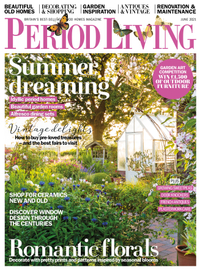The upwardly sloping plot stretches out from Kate and Hitesh Patel’s 18th-century home on the English/Welsh border, and creates a beautiful vista that blends with woodlands, meadows and views of the Wye Valley towards Avonmouth. So how did the couple create a long season of interest with garden ideas? The answer is prairie-style planting. This style of planting, popularised by the Dutch designer Piet Oudolf, uses combinations of ornamental grasses and flowering perennials that gradually build throughout the year to produce dazzling displays by midsummer. Prairie style planting tolerates drought and gusty winds and is quick to establish and is one of the ways to plan a dry garden. Kate and Hitesh planted their garden for year round interest, and it’s packed with sloping garden ideas that are perfect for awkward sites, too.
1. Use of ornamental grasses
When the couple moved to the property it wasn’t immediately obvious what they should do, or how to plan the garden. ‘The site had been an uninspiring slope covered in patchy grass, and the soil is very thin, with pudding stone underneath. Over the years neighbors cut down stands of conifers, affording us occasional long views, but also stiffer winds that come up from the River Severn,’ explains Kate. Kate and Hitesh sought the advice of horticulturalists Roger Grounds and Diana Grenfell. ‘Roger is a grass specialist and we had already picked up some of his books at Kew. We lived for years in South-East Asia, so planting with grasses seems natural to us after having lived over there,’ Kate explains. Together they drew up an ambitious prairie styles scheme using some 50 different types of grasses. ‘We chose warm season deciduous grasses for their functional and architectural qualities and association with the landscape, and the way they capture the light and dance en masse in the valley breeze,’ explains Kate. The beauty of growing ornamental grasses and prairie planting includes their speed in becoming established, and dynamism. ‘The grasses and perennials give the garden a strong sense of energy and are easy to maintain,’ says Hitesh.
2. Planting perennials
Along with the grasses, the couple have planted horizontal bands of perennials, such as rudbeckia, persicaria, echinacea and sedum, which complement surrounding shrubs and trees. ‘When you’re planting perennials in blocks you have to look at the seed heads and pick ones that will look good for a long time – I don’t cut things down until I absolutely have to,’ says Kate. Come winter, the borders are filled with attractive seed heads that look fabulous covered in frost. This is among the many choices for flower bed ideas.
3. Bold plant combinations
The Patels have had the confidence to use certain plants in bold and unusual ways. This includes the 200ft long miscanthus hedge that creates an elegant screen of purple plumes at the back of the plot. Also the Calamagrostis x acutiflora ‘Overdam’ that provide a ‘pillar’ effect on a lower level. Plantings of hydrangeas has been inspired by the river of shrubs at Trebah Gardens in Cornwall, and add color to the garden’s boundaries later in the summer. Dumpy pines and several bamboos, the latter grown in raised garden beds lined with damp-proof membrane, are among the species prized for their screening abilities.
4. Creating a patio area
A sunny sunken patio close to the house provides a change in tempo, with vibrant magenta and orange-colored flowers contrasting with cream walls and blending with the pink paving. It is in this area that many of the Patels’ pots are put to good use displaying annuals, such as growing cosmos bipinnatus Sonata Series, which flowers later in the summer, along with dainty tactile grasses like Pennisetum ‘Fairy Tails’ with its pink-tinged feathery spikes above beautiful green leaves. Tall cannas stand out against the cream walls and dark-leaved heucheras work together to provide an effective edging. ‘We spend a lot of time out here eating or reading; it’s a wonderful place,’ explains Kate. More pots have found their way to the terrace around their house, including two that are used to grow glorious roses – growing roses in pots is one of many rose garden ideas.
5. Combining crops and perennials in a vegetable garden
Kate and Hitesh’s productive vegetable garden ideas feature a series of raised beds filled with a variety of crops. These include architectural artichokes and arches of growing sweet peas. The vegetable crops are mixed with flowering perennials and screened with statuesque nasturtiums that extend the exuberant feel of prairie planted beds to this part of the garden. Nasturtiums also act as good companion plants for many vegetable and fruit crops. The area is screened by the bamboo Phyllostachys vivax, which provides shelter against the wind. The sloping nature of the garden means the Patels get to enjoy a glorious sight from whichever angle they head after leaving the front door of their home, which was originally built as an apple store, and went on to serve at various times as two cottages, a pottery and even a commune. ‘We were lucky to find this house and garden, which, although awkward in terms of shape and being on a slope, is an interesting space,’ says Kate. ‘Our aim was to have a wonderful vista that would link our garden with the surrounding beauty of the landscape.’ Subscribe to Period Living for more inspiration (opens in new tab) Period Living is the UK’s best-selling period homes magazine. A subscription provides you with all you need to know about caring for and improving a traditional house and garden.
